Self-propelled howitzers of the Second World War. Part of 3. Semovente da 75 / 18
The battles that the Italian troops fought at the North African theater of operations in 1940-1941, clearly showed all the weakness of the armored forces of fascist Italy. In this case, the most fruitful in terms of obtaining new armored vehicles for Italy was 1941, when light and medium-sized troops entered the troops Tanks new types, as well as self-propelled units Semovente da 47/32 and Semovente da 75/18. Of these, it was the second one that gained the greatest popularity in Italian troops.
Attempts to significantly improve the tactical and technical characteristics of the average for the Italian classification of the tank M13 / 40 (although by weight it fell into the category of light tanks) through modernization did not lead to anything. Then the Italians decided to turn to the German experience in the use of StuG III Ausf B assault guns during battles in France. The Italian military wanted to have at their disposal an analogue of such a machine. As a result, several prototypes were built based on the M13 / 40 tank, from which the Ansaldo variant was chosen. The order for the mass production of new SAUs followed in January 1941. Serial machines were designated Semovente da 75 / 18.
It is worth noting that the Italian military were really impressed by the combat experience of their German allies, obtained during the French campaign. It was then that the German assault guns Sturmgeschütz III (abbreviated as StuG III), reckless self-propelled artillery units based on the Panzerkampfwagen III medium tank, debuted in combat conditions. StuG III was a combat vehicle, distinguished by its low silhouette and strong enough for its time booking - up to 50 mm. At the same time armed with the installation of short-barreled 75-mm gun. The main purpose of this technology was the direct fire support of tanks and infantry on the battlefield. StuG III had to fight with anti-tank artillery and enemy machine-gun points, its field-type fortifications. I must say in France, the German assault guns have shown themselves in all their glory.
In Italy, could not help noticing it. Artillery Colonel Sergio Berleze, who led the development of Obice da 75 / 18 mountain howitzer, put forward a proposal for its installation on the chassis of the M13 / 40 tank. He proposed to repeat what the Germans had turned with the conversion of PzKpfW III to StuG III. The Artillery Inspectorate of the General Staff Reggio Ezerchito accepted the proposal received from Berlese. The first prototype of the new Italian SAU was already ready for 10 February 1941 of the year.
From a technical point of view, the new Italian SAU was a chassis of the M13 / 40 tank with a classic layout with a front-mounted transmission, which was equipped with an Obnice da 75 / 75 M18 34 howitzer installed by Ansaldo. The howitzer was located in the armored wheelhouse installed in the middle of the hull. The barrel group was installed in two armored hemispherical parts that provided very comfortable guidance angles. The angles of horizontal guidance were 20 degrees to the left and 18 degrees to the right - this was an excellent indicator in comparison with similar machines of those years. The corners of the vertical guidance of the gun ranged from -12 to + 22 degrees.
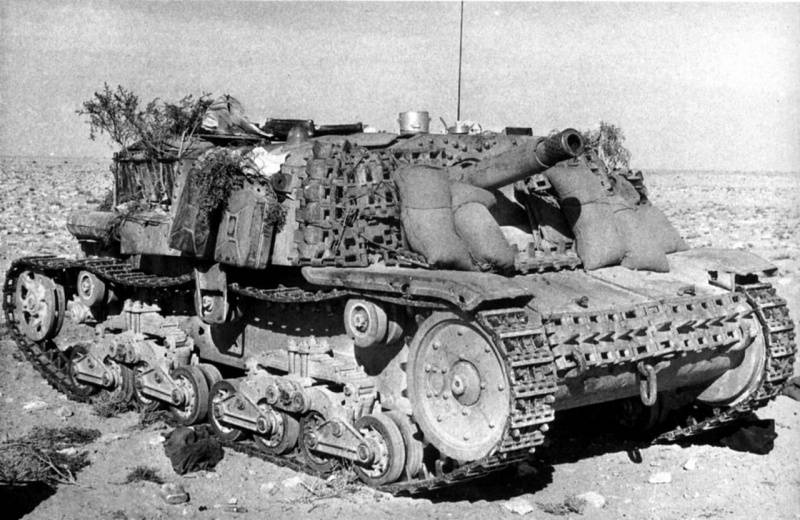
But the gun itself was not outstanding. The Italian 75-mm divisional gun-howitzer Obice da 75 / 18, which was originally developed as a mountain howitzer, in its range, the initial velocity of the projectile and armor penetration significantly inferior to any divisional guns of the same caliber that were used by other countries. Indeed, the barrel length in 18 calibers seriously complicated the task of dealing with enemy armored vehicles, but did not make it impossible.
Ammunition of this howitzer, as a rule, included two types of ammunition: armor-piercing and high-explosive fragmentation projectiles. In this high armor penetration, this artillery installation could not boast. The initial flight speed of the armor-piercing projectile was 425 m / s. According to German data, 75-mm caliber armor-piercing armor penetration armor was up to 45 mm of homogeneous armor at an encounter angle of 30 degrees relative to the normal to the armor plate at a distance of 500 meters. With increasing distance to the target, armor penetration decreased to 40 mm at a distance of 1000 meters. The use of cumulative ammunition Effetto Pronto Speziale rectified the situation. With their help, it was possible to pierce armor with a thickness of 70-80 mm. When using cumulative ammunition installation could effectively deal with tanks "Matilda" and "Sherman." The entire ammunition of the Semovente da 75 / 18 SAU consisted of 44 unitary shots and 1104 machine-gun cartridges.
The body of the self-propelled gun Semovente da 75 / 18 was assembled from surface-hardened rolled armored plates of different thickness, which were attached to the frame from the corners with the help of riveting. SAU reservation was differentiated, anti-bullet-protivosnaryadnoe, all armor plates were installed without significant tilt angles. The frontal armor plate of the felling had the greatest thickness in 50 mm, and the remaining parts of the self-propelled gun hull inherited from the base chassis of the tank did not change: the bent lower frontal hull detail had a cylindrical shape, its thickness was 30 mm, the hull sides were 25 mm. In the frontal part of the cabin, which was a single armor plate, the factory cut two holes: a round embrasure, designed to install the main armament and a rectangular hatch-stopper of the driver, designed to monitor the environment. The cabin roof was formed from three flat armor plates - a horizontal central plate and two bevels to the sides of the self-propelled gun. Behind the flat part of the roof were two hatches for the landing-disembarking crew of the ACS. The hatches were large enough and hinged on hinges. For servicing the transmission and engine elements, as well as other Semovente da 75 / 18 units and assemblies, there was a fairly large number of hatches, hatches, and technological holes on the casing.
The body of the self-propelled gun was divided into three main compartments: transmission, combat and power, counting from the bow of the machine to the stern. The power compartment was separated from the military with the help of a transverse protective bulkhead. Torque from the engine was transmitted to the self-propelled engine transmission units using a propeller shaft, which passed through the fighting compartment. Two jobs for the crew members were on the left, one - to the right of the propeller shaft. Two self-propelled guns had to simultaneously perform the functions of a commander, gunner, loader and radio operator, only the driver was not overloaded with additional functional duties. The German counterpart StuG III crew did not consist of three, but of four people, which positively affected the performance of functional duties.
Suspension self-propelled was borrowed from the tank M13 / 40. The twin small-diameter track rollers were interlocked in pairs in a small carriage; a pair of such small carriages fastened at the ends of two balances of a large carriage on transverse axes. Above the weights of the big cart was an elastic element — a semi-elliptical leaf spring. In relation to each board, the self-propelled vehicle's chassis included two large bogies, a rear sloth, a leading front wheel, and three supporting rollers for the upper branch of the tracks. In general, the design of the self-propelled howitzer Semovente da 75 / 18 su scafo M40 was estimated by the Italians as quite successful, distinguished by unpretentiousness and ease of maintenance. In total, the 13 SAU Semovente da 40 / 60 was assembled based on the M75 / 18 tank. On self-propelled guns of this modification was put 125-strong diesel engine SPA 8 TM40 V-8.
After the Italian industry made the transition to the production of the upgraded model of the M14 / 41 tank, the production of self-propelled guns was continued on their basis. Accordingly, the machines received a new designation Semovente da 75 / 18 su scafo M41, in total 162 of such self-propelled guns were released. An important improvement of this modification was the new 145-strong engine SPA 15T, as well as the anti-aircraft 8-mm machine gun Breda, which could also be used for self-defense of self-propelled guns from enemy infantry in close combat. Since the changes in the undercarriage were very small, the same technological equipment was used for the production of Semovente as for tanks. This made it possible to produce in 1942 a fully combat-ready armored vehicle on the base chassis of a tank that was hopelessly outdated by that time.
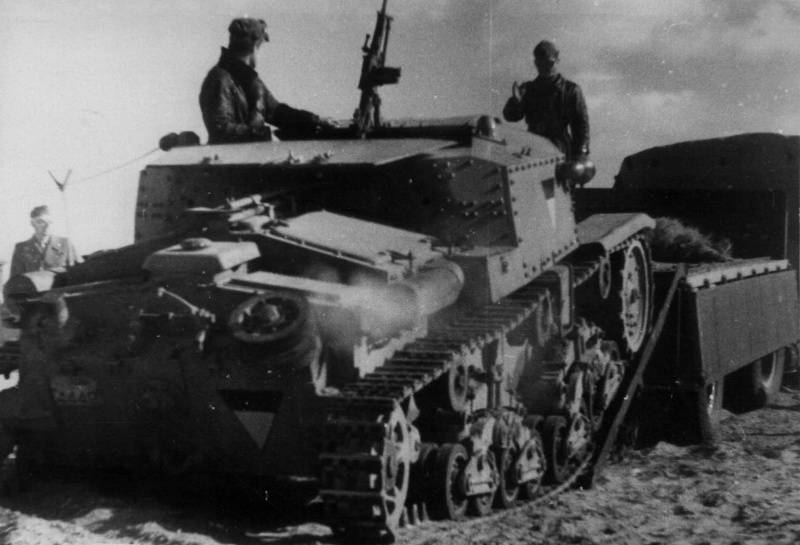
After adopting the next M15 / 42 tank for the Italian army, 245 self-propelled rigs were launched, now at its base. They received the designation Semoventi da 75 / 18 su scafo M42. In production, these installations survived the tank donor itself. These machines were equipped with the most powerful engine of all ACS of this type. On them stood the SPA 15TB motor, which developed the power of the 195 HP. True, if on the two previous models the power plant was diesel, then here it worked on gasoline.
The Semovente da 75 / 18 self-propelled guns were combined mainly into divisions (Italian Gruppo), initially consisting of two and then three batteries, a control platoon and smaller units (supply, medical, etc.). The early version of the organizational structure of the self-propelled artillery battalion included two 4 SAU batteries. Since the 1943 year, the firepower of the unit has grown more than 2 times - there were three batteries, and the number of self-propelled guns in them was brought to 6 units. The control platoon was armed with 4 special command and staff vehicles, the Carro Comando per Semoventi, which was a reckless version of the M13 / 40 or M14 / 41 tanks. These machines had installed distance measuring, angle and communication equipment.
The Italian self-propelled gun Semovente da 75 / 18 has become one of the most striking examples of successful conversion of a hopelessly obsolete tank base into a fully combat-ready ACS. Despite the tactical and technical characteristics modest at that time compared with foreign counterparts and the strong archaic nature of a number of technical solutions in the design that the self-propelled machine inherited from the base tank, for Italian industry and tank design Semovente da 75 / 18 was very important.
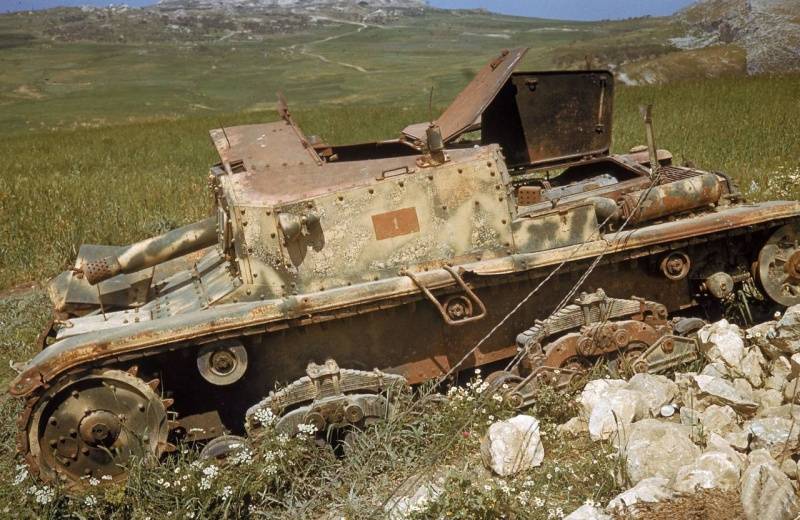
The low height of the ACS Semovente da 75 / 18, made it easy to mask it on the ground. However, a gun with a muzzle brake at the time of the shot inevitably betrayed the location of the self-propelled gun. Self-propelled mobility was quite adequate, although it was never outstanding in terms of the maximum speed developed. Acceptable anti-tank capabilities were provided using cumulative projectiles, ambush tactics, good aiming devices for firing, and usually good training of Italian self-propelled guns.
Reserving the Semovente da 75 / 18 self-propelled gun, located mainly without rational tilt angles, could provide frontal protection only against 37-mm and 40-mm projectiles at large combat distances or in the case where the projectile with the armor is favorable relative to the normal. British 57-mm tank and anti-tank guns punched 50-mm cutting of the Italian self-propelled gun at most distances of real combat. The same was true for the 75-mm tank guns of the American "Grants" and "Shermans".
The main disadvantages of the self-propelled unit, in addition to the already mentioned weak booking, were the low speed and strong gas content of the fighting compartment when firing. Shooting from the ACS could only be with open hatches. According to the reviews of the Italian crews, the temperature inside the fighting compartment of self-propelled guns when firing in hot African climates often reached 60 degrees Celsius. And dust and grains of powder raised by powder gases could get into the combat vehicle through open hatches. As a result, the shooting conditions for the crew were very difficult.
Tactical and technical characteristics of Semovente da 75 / 18 su scafo M40:
Overall dimensions: length - 4915 mm, width - 2280 mm, height - 1850 mm, clearance - 410 mm.
Combat weight - 14,4 t.
Reservations - from 10 (roof) to 50 mm (forehead felling).
Armament - 75-mm howitzer Obice da 75 / 18 and 8-mm machine gun Breda Mod.38.
Ammunition - 44 shot and 1104 cartridge to the machine gun.
The power plant is a 8-cylinder diesel engine SPA 8 TM40 liquid-cooled horsepower 125.
Maximum speed - 32 km / h (on the highway).
Power reserve - 200 km (on the highway).
Crew - 3 person.
Information sources:
http://armor.kiev.ua/Tanks/WWII/sem
http://armor.kiev.ua/wiki/index.php?title=Semovente_da_75/18
http://www.aviarmor.net/tww2/tanks/italy/sem75_18.htm
Open source materials
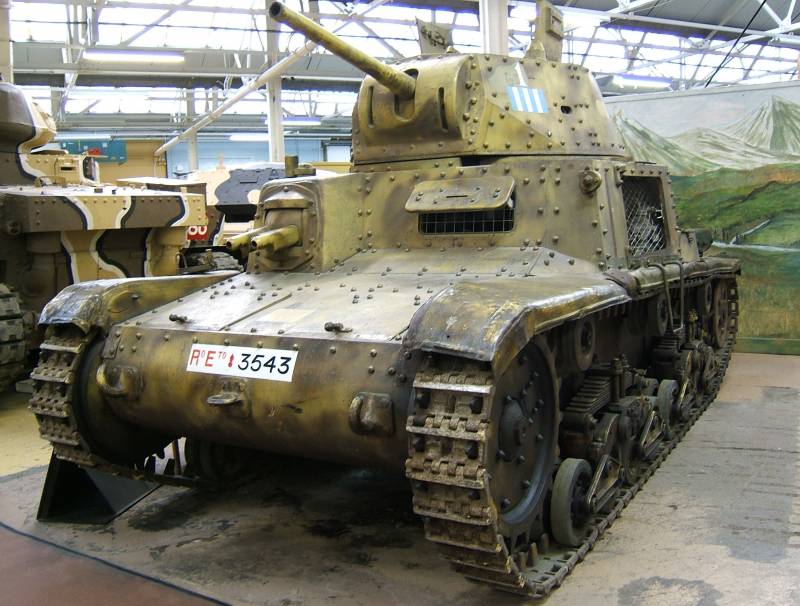
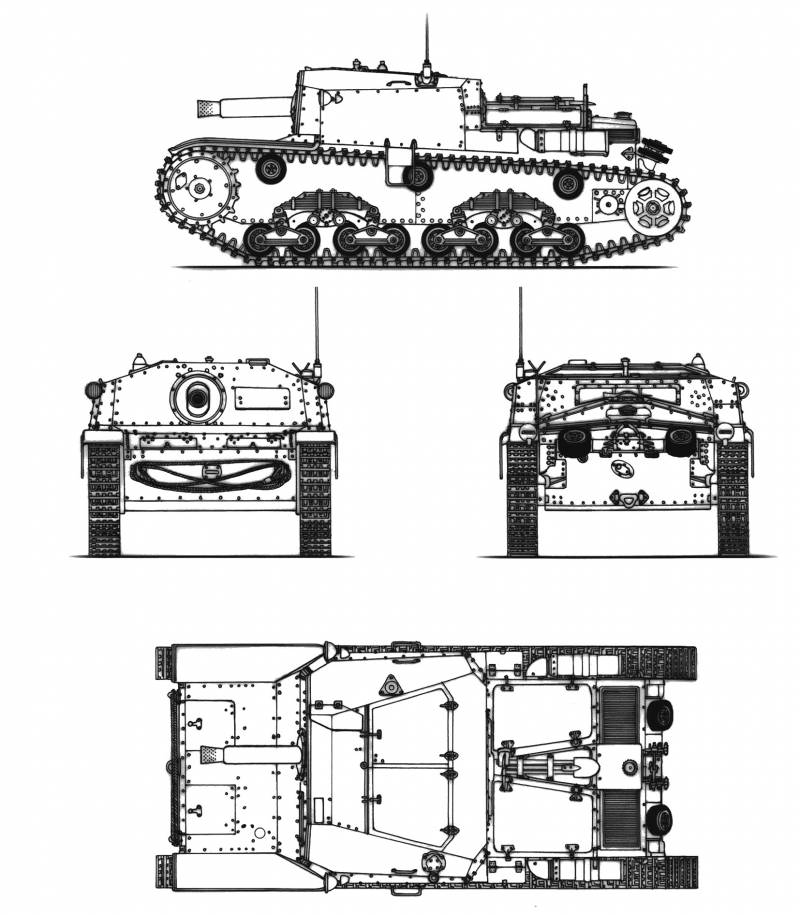
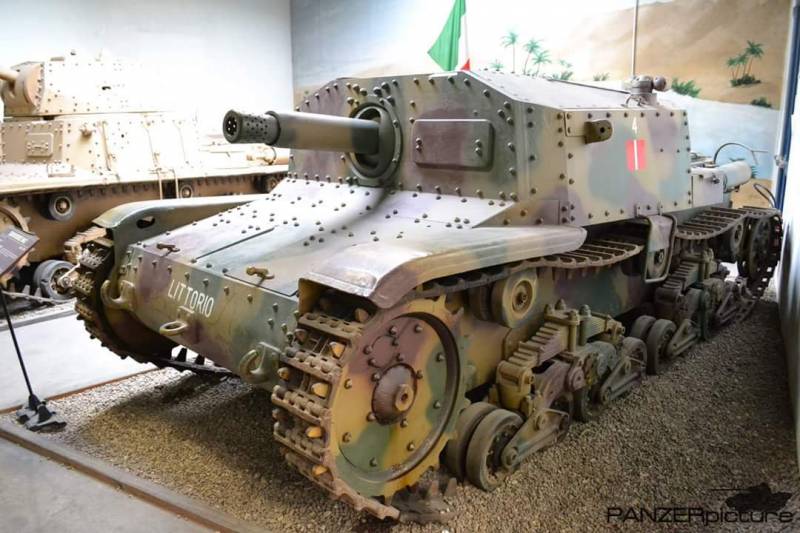
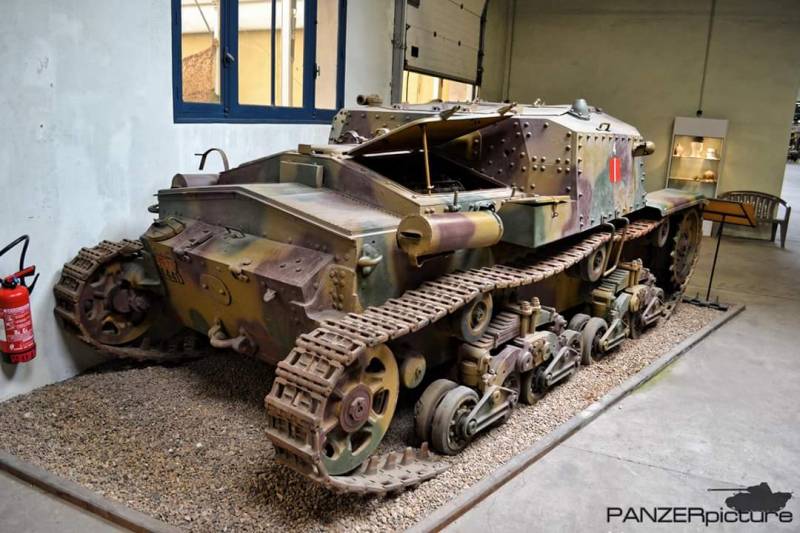
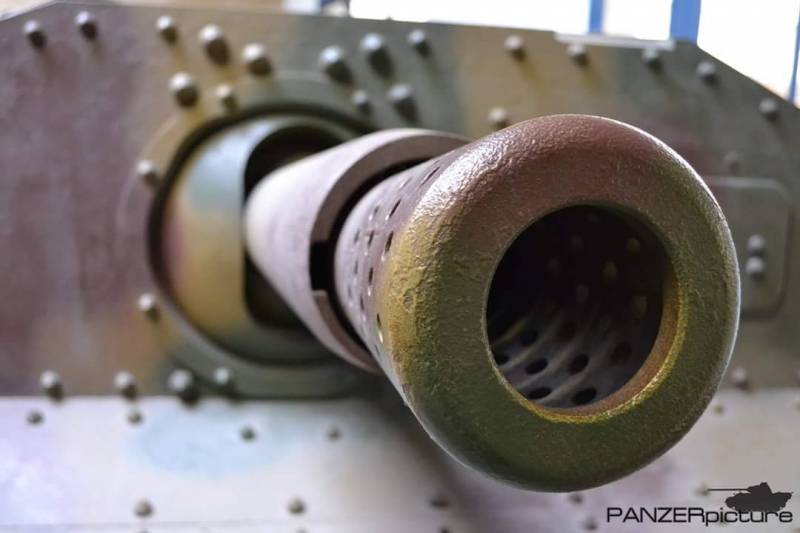
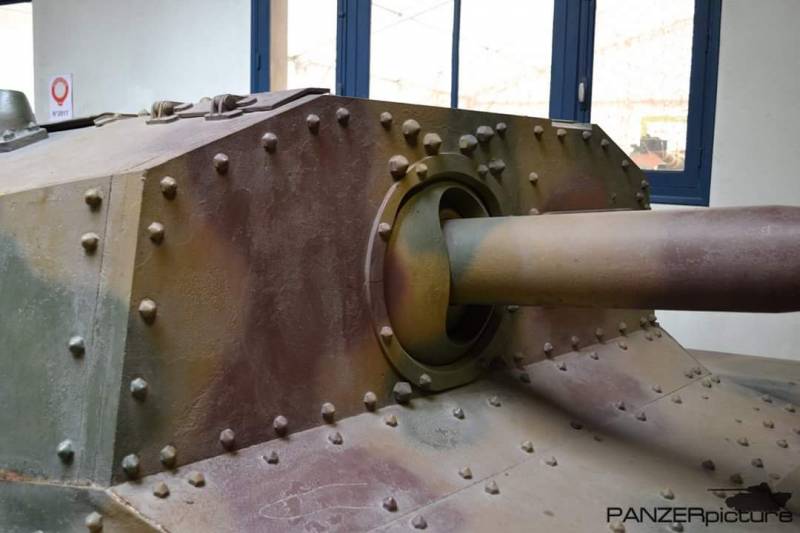
Information